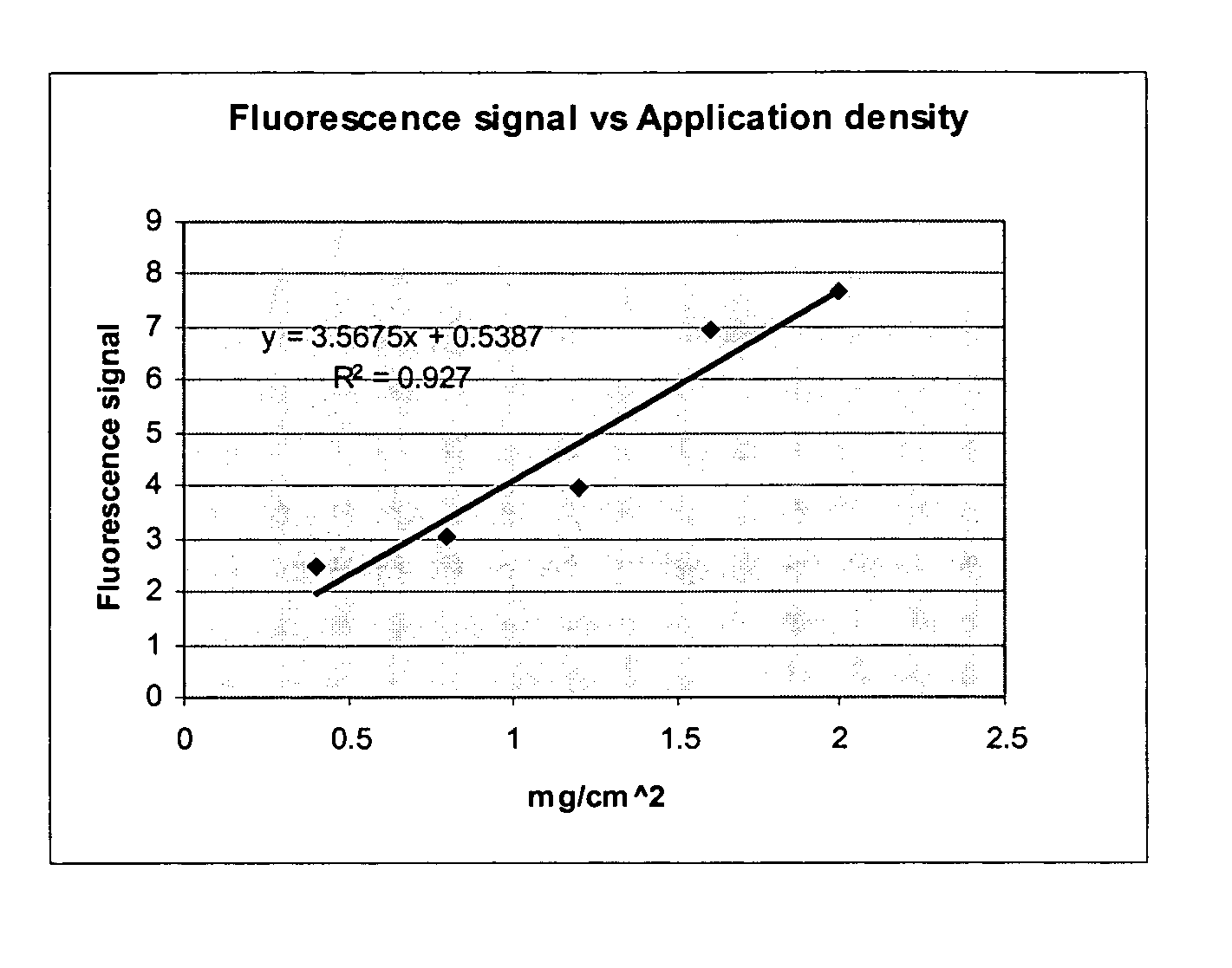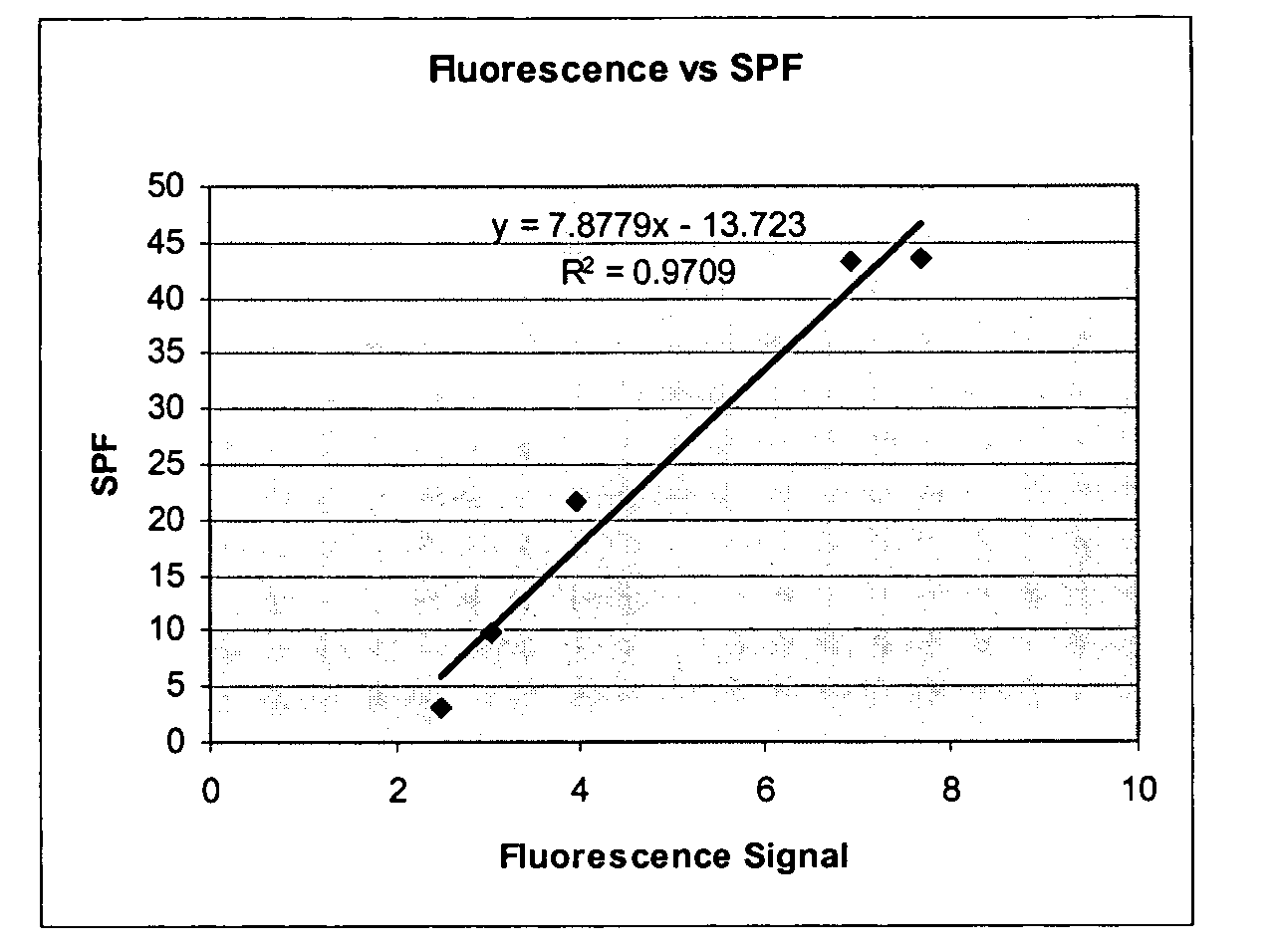Topical composition detection
- Summary
- Abstract
- Description
- Claims
- Application Information
AI Technical Summary
Benefits of technology
Problems solved by technology
Method used
Image
Examples
example 1
[0094] A composition according to the invention was made by adding 0.1 g of DFSB-K43 from Risk Reactor of Huntington Beach, Calif. to 100 g of SUNDOWN SPF 60 sunscreen product. The composition was then applied to the surface of a ground surface PMMA plate at densities ranging from 0.5, 1.0, 1.5, 2.0, and 2.5 mg / cm2 (approximately 1″ square test sites). The fluorescence of the DFSB-K43 in the applied sunscreen was measured by exciting the of DFSB-K43 with 450 nm radiation (from a monochromator), and measuring the emission fluorescence at 500 nm. The fluorescence intensity over the test area was measured using 4 individual measurements, and the results are plotted below.
[0095] The fluorescence intensity was highly correlated with the application density of the composition r2=0.927 indicating that this technique is indicative of product application density and is predictive of product application quantity.
example 2
[0096] The same sample preparation was measured using conventional in vitro SPF measurement equipment, Labsphere UV spectrophotometer, to evaluate the SPF of each of the application density samples. The relationship between the fluorescence signal of the fluorescent chromophore in the sunscreen is shown to clearly correlate with the SPF of the product on the plate.
[0097] In this example, a threshold fluorescent level of at least 6 would be required to indicate that sufficient sunscreen had been applied to the skin. The diagnostic tool would then indicate a “Yes” signal, that sufficient sunscreen was in place. The indicator may be a green glowing light, or a LCD indicator, or a “meter” showing “Good”. Fluorescence below this value of 6 would signal insufficient sunscreen coverage with a “No” signal such as a red light, a “no” LCD indicator or a meter showing “Not Enough” for example.
example 3
[0098] A sample of an SPF 30 sunscreen preparation containing the 0.1% Yellow Dye #43 was prepared on a ground surface PMMA plate at a density of 1.6 mg / cm2 and allowed to dry for approximately 10 minutes. The SPF of the sample and the fluorescence signal from the sample were measured as above with both the spectrofluorimeter device, and the Labsphere SPF spectrophotometer. After the initial measurements, the sample was placed under vigorously running tap water for ten to 15 seconds, and rubbed lightly with a fingertip in the stream of water, and the measurements were repeated again. The fluorescence signal decreased after washing / rubbing, indicating that some of the fluorescent chromophore was removed. However, it can be noted that the slope of the line in Example 2 is very similar to Example 1 (within about 12%), indicating that the fluorescence chromophore and UV-filter are removed in approximately the same proportion. This suggests that the fluorescence chromophore and UV-filter...
PUM
| Property | Measurement | Unit |
|---|---|---|
| Percent by mass | aaaaa | aaaaa |
| Wavelength | aaaaa | aaaaa |
| Composition | aaaaa | aaaaa |
Abstract
Description
Claims
Application Information
 Login to view more
Login to view more - R&D Engineer
- R&D Manager
- IP Professional
- Industry Leading Data Capabilities
- Powerful AI technology
- Patent DNA Extraction
Browse by: Latest US Patents, China's latest patents, Technical Efficacy Thesaurus, Application Domain, Technology Topic.
© 2024 PatSnap. All rights reserved.Legal|Privacy policy|Modern Slavery Act Transparency Statement|Sitemap



